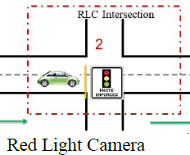Article from: www.thenewspaper.com/news/64/6492.asp
6/27/2018
Maryland DOT Study Shows How Camera Studies Are Gamed
Study demonstrates mixed impact on accidents after red light cameras are used in Maryland.
 Red light camera programs generate millions for local governments that, in turn, commission studies to bolster the case for their continued use. A study released last week by the Maryland Department of Transportation highlights the dramatic impact that have on the reported results.
Red light camera programs generate millions for local governments that, in turn, commission studies to bolster the case for their continued use. A study released last week by the Maryland Department of Transportation highlights the dramatic impact that have on the reported results.
"For example, if the crash data from the two years before period was used as the baseline to compare to the three-year crash data in the after period, then the conclusion was either 'no change' or 'an increase' in the frequencies of side-impact crashes," researchers noted regarding the intersection of MD 355 and Halpine Road in Montgomery County. "A quite different conclusion, however, was reached if the crash data from the five years before period is used."
Researchers at the University of Maryland-College Park took 27 red light camera intersections in Howard, Montgomery and Prince George's and found the devices produced mixed results in terms of accidents.
"Several intersections (ie., three to nine, depending on the selected comparison time period), showed an increase in such crash patterns during the 'after' period," the researchers found.
The researchers noted that many drivers find themselves trapped in a "dilemma zone" where they face the choice of either stopping when the light turns yellow or proceeding through the intersection before it turns red. The study found that particular intersections had a tendency to encourage drivers to slam on the brakes for fear of getting a photo ticket when they should have proceeded safely through the intersection.
"The percentage of drivers who decided to stop when in the 'must-go' zone was 12 percent at the MD 650 intersection, 3.9 percent at the US 301 intersection, 10.1 percent at the MD 450 intersection, and 2.9 percent at the MD 97 intersection," the study found. "Conceivably, this might cause rear-end collisions."
At ten intersections overall, the increase in rear-end collisions was significant. Municipalities have an incentive to showcase any positive results for the photo ticketing program. Montgomery County, for example, generated $4,361,912 in profit from red light cameras last year, in addition to $17,772,633 from speed cameras. Statewide, a total of 45 local jurisdictions generated $54,802,197 in speed camera revenue last year, and the Maryland DOT generated $9.1 million from its speed camera program in 2016. The new study, which was funded by the Maryland DOT, concluded that the cameras are positive on balance.
"When implementing the RLC program, great care should be exercised to prevent some potential negative effects on traffic safety," the researchers concluded.
A copy of the study is available in a 1.3mb PDF file at the source link below.
Source: Evaluating the Impacts of Red Light Camera Deployment (Maryland Department of Transportation, 6/18/2018)
Permanent Link for this item
Return to Front Page
 Red light camera programs generate millions for local governments that, in turn, commission studies to bolster the case for their continued use. A study released last week by the Maryland Department of Transportation highlights the dramatic impact that have on the reported results.
Red light camera programs generate millions for local governments that, in turn, commission studies to bolster the case for their continued use. A study released last week by the Maryland Department of Transportation highlights the dramatic impact that have on the reported results.